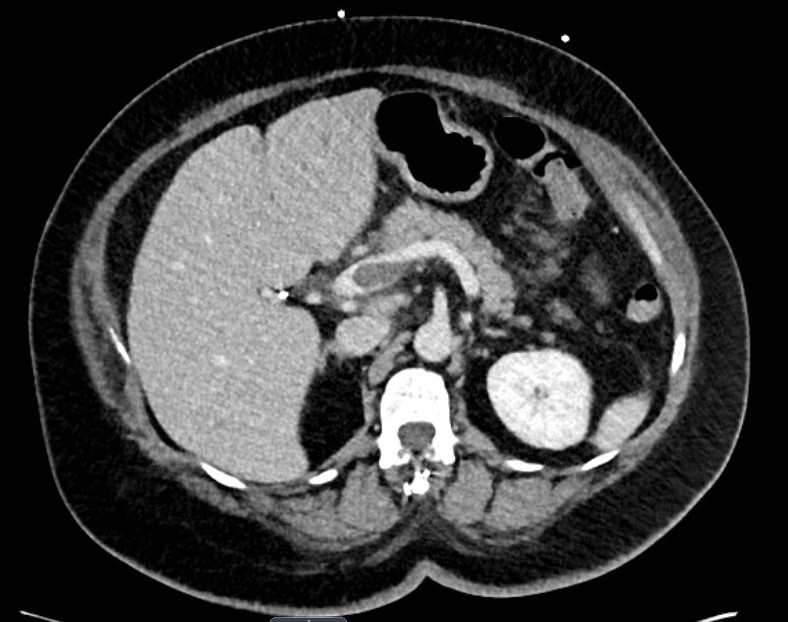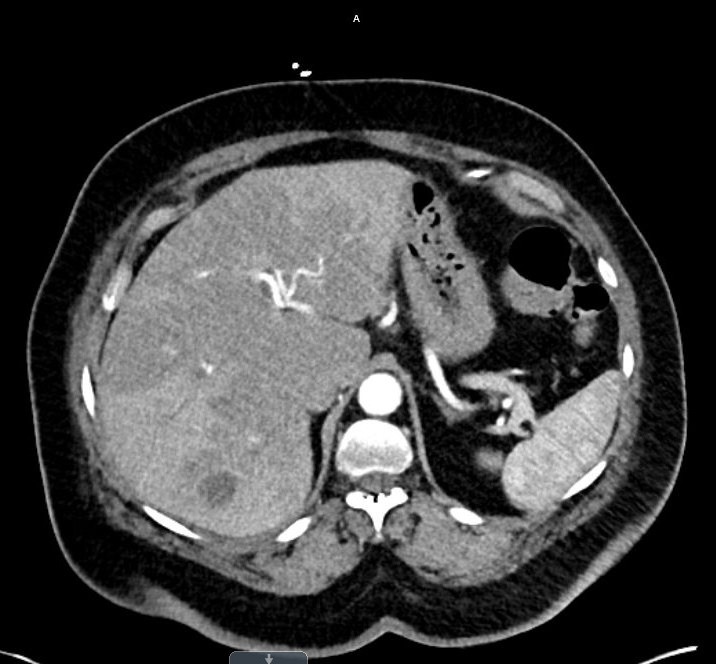Tuesday Poster Session
Category: Liver
P6097 - Pylephlebitis-Induced Recurrent Liver Abscess: A Complication of Gangrenous Appendicitis
Tuesday, October 28, 2025
10:30 AM - 4:00 PM PDT
Location: Exhibit Hall

Abirami Rajendiran, MD (she/her/hers)
Texas Tech University Health Sciences Center
El Paso, TX
Presenting Author(s)
Abirami Rajendiran, MD, Deipthan Prabakar, MD, Bansi Sutariya, MD, Daniel Neri Rosario, MD, Omer Usman, MD, Azucena Del Real, MD, Sindhu Goddanakoppal Rajendra, MD, Sherif E. Elhanafi, MD
Texas Tech University Health Sciences Center, El Paso, TX
Introduction: Pylephlebitis, or suppurative thrombophlebitis of the portal vein, is a rare but serious complication that usually arises from intra-abdominal infections such as diverticulitis, appendicitis, or other sources of abdominal sepsis. We present the case of a 62-year-old female diagnosed with pylephlebitis associated with recurrent liver abscesses.
Case Description/
Methods: This is a case of a 62-year-old female with PMH of Type 2 DM, hyperlipidemia, and chronic back pain, who presented to the ER with severe epigastric pain. Initial laboratory investigations revealed leukocytosis and elevated lipase levels, meeting criteria for acute pancreatitis. However, imaging studies ruled out pancreatitis and instead revealed portal vein thrombosis with multiple pyogenic liver abscesses, without evidence of intra-abdominal inflammation. Percutaneous drainage yielded 50 cc of purulent fluid, but cultures and other infectious workup returned negative, raising suspicion for an underlying malignancy. The patient returned to the emergency department several weeks later with recurrent abdominal pain. Imaging once again revealed multiple liver abscesses along with a prominent paracolic lymph node. Initial workup, including CT-Abdomen, was inconclusive. However, during a later episode of worsening abdominal pain, repeat imaging and surgical exploration ultimately revealed gangrenous appendicitis, which had not been visible on previous scans. Microbiological cultures from abscess fluid identified Bacteroides thetaiotaomicron species, and histopathological evaluation confirmed the diagnosis of gangrenous appendicitis. There was no evidence of malignancy. The patient was treated with a combination of broad-spectrum intravenous antibiotics and anticoagulation. Surgical appendectomy served as a definitive source control, and subsequent targeted antimicrobial therapy led to the resolution of the recurrent hepatic abscesses and portal vein thrombosis. The patient was discharged with instructions to follow up as an outpatient with her primary care.
Discussion: This case underscores the diagnostic challenge posed by atypical presentations of appendicitis and highlights the importance of considering occult intra-abdominal infections in patients with recurrent liver abscesses and pylephlebitis. Early recognition and comprehensive treatment—including appropriate antimicrobial therapy, anticoagulation, and surgical intervention—are essential to prevent progression to severe septic complications and improve clinical outcomes.

Figure: Portal Vein Thrombus

Figure: Multiple abscess
Disclosures:
Abirami Rajendiran indicated no relevant financial relationships.
Deipthan Prabakar indicated no relevant financial relationships.
Bansi Sutariya indicated no relevant financial relationships.
Daniel Neri Rosario indicated no relevant financial relationships.
Omer Usman indicated no relevant financial relationships.
Azucena Del Real indicated no relevant financial relationships.
Sindhu Goddanakoppal Rajendra indicated no relevant financial relationships.
Sherif Elhanafi indicated no relevant financial relationships.
Abirami Rajendiran, MD, Deipthan Prabakar, MD, Bansi Sutariya, MD, Daniel Neri Rosario, MD, Omer Usman, MD, Azucena Del Real, MD, Sindhu Goddanakoppal Rajendra, MD, Sherif E. Elhanafi, MD. P6097 - Pylephlebitis-Induced Recurrent Liver Abscess: A Complication of Gangrenous Appendicitis, ACG 2025 Annual Scientific Meeting Abstracts. Phoenix, AZ: American College of Gastroenterology.
Texas Tech University Health Sciences Center, El Paso, TX
Introduction: Pylephlebitis, or suppurative thrombophlebitis of the portal vein, is a rare but serious complication that usually arises from intra-abdominal infections such as diverticulitis, appendicitis, or other sources of abdominal sepsis. We present the case of a 62-year-old female diagnosed with pylephlebitis associated with recurrent liver abscesses.
Case Description/
Methods: This is a case of a 62-year-old female with PMH of Type 2 DM, hyperlipidemia, and chronic back pain, who presented to the ER with severe epigastric pain. Initial laboratory investigations revealed leukocytosis and elevated lipase levels, meeting criteria for acute pancreatitis. However, imaging studies ruled out pancreatitis and instead revealed portal vein thrombosis with multiple pyogenic liver abscesses, without evidence of intra-abdominal inflammation. Percutaneous drainage yielded 50 cc of purulent fluid, but cultures and other infectious workup returned negative, raising suspicion for an underlying malignancy. The patient returned to the emergency department several weeks later with recurrent abdominal pain. Imaging once again revealed multiple liver abscesses along with a prominent paracolic lymph node. Initial workup, including CT-Abdomen, was inconclusive. However, during a later episode of worsening abdominal pain, repeat imaging and surgical exploration ultimately revealed gangrenous appendicitis, which had not been visible on previous scans. Microbiological cultures from abscess fluid identified Bacteroides thetaiotaomicron species, and histopathological evaluation confirmed the diagnosis of gangrenous appendicitis. There was no evidence of malignancy. The patient was treated with a combination of broad-spectrum intravenous antibiotics and anticoagulation. Surgical appendectomy served as a definitive source control, and subsequent targeted antimicrobial therapy led to the resolution of the recurrent hepatic abscesses and portal vein thrombosis. The patient was discharged with instructions to follow up as an outpatient with her primary care.
Discussion: This case underscores the diagnostic challenge posed by atypical presentations of appendicitis and highlights the importance of considering occult intra-abdominal infections in patients with recurrent liver abscesses and pylephlebitis. Early recognition and comprehensive treatment—including appropriate antimicrobial therapy, anticoagulation, and surgical intervention—are essential to prevent progression to severe septic complications and improve clinical outcomes.

Figure: Portal Vein Thrombus

Figure: Multiple abscess
Disclosures:
Abirami Rajendiran indicated no relevant financial relationships.
Deipthan Prabakar indicated no relevant financial relationships.
Bansi Sutariya indicated no relevant financial relationships.
Daniel Neri Rosario indicated no relevant financial relationships.
Omer Usman indicated no relevant financial relationships.
Azucena Del Real indicated no relevant financial relationships.
Sindhu Goddanakoppal Rajendra indicated no relevant financial relationships.
Sherif Elhanafi indicated no relevant financial relationships.
Abirami Rajendiran, MD, Deipthan Prabakar, MD, Bansi Sutariya, MD, Daniel Neri Rosario, MD, Omer Usman, MD, Azucena Del Real, MD, Sindhu Goddanakoppal Rajendra, MD, Sherif E. Elhanafi, MD. P6097 - Pylephlebitis-Induced Recurrent Liver Abscess: A Complication of Gangrenous Appendicitis, ACG 2025 Annual Scientific Meeting Abstracts. Phoenix, AZ: American College of Gastroenterology.
